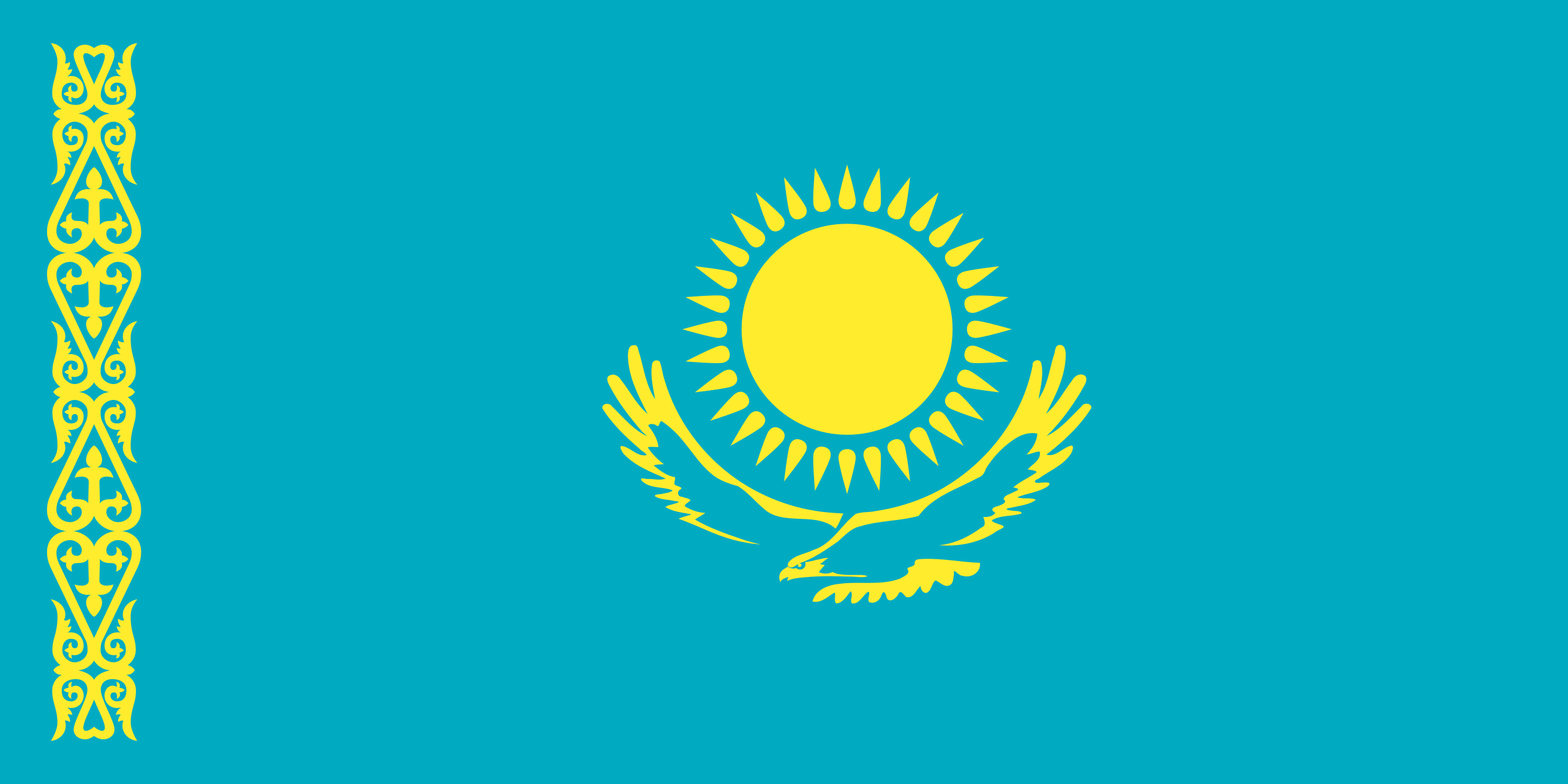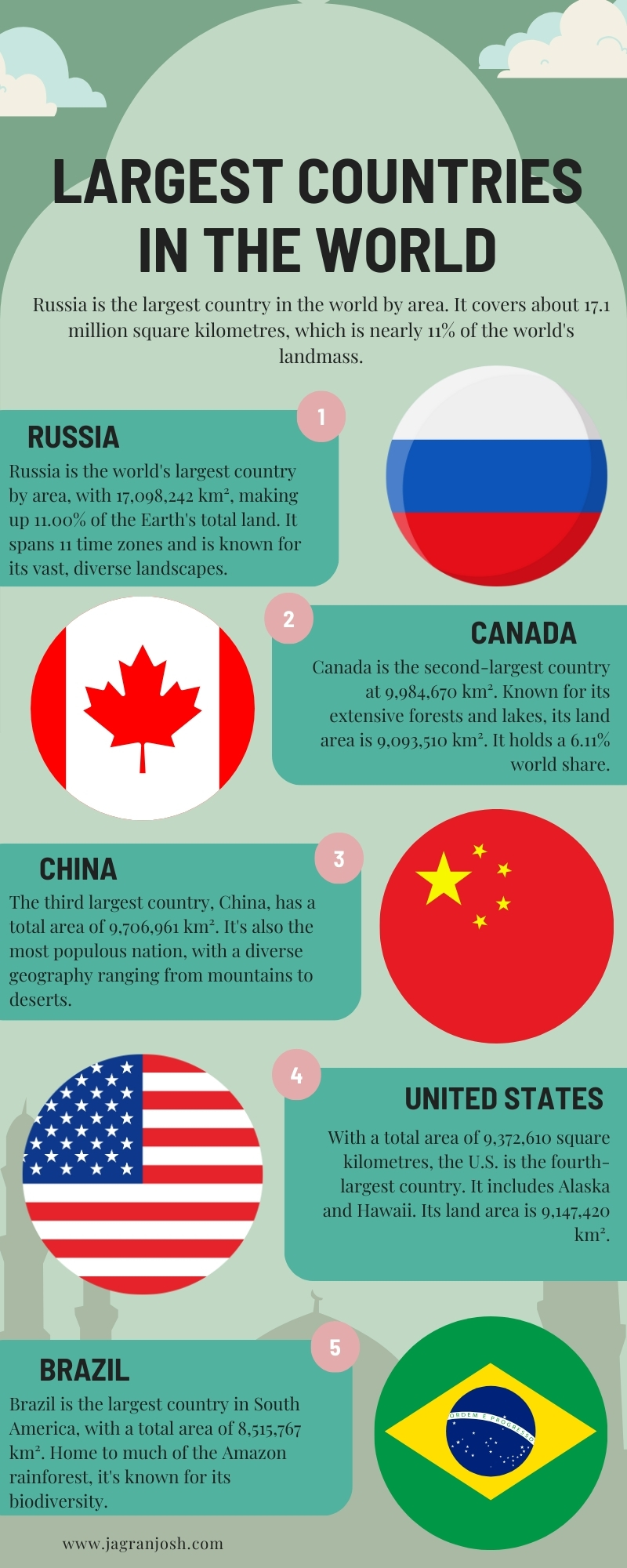With a total of 195 countries in the world, have you ever wondered which country takes up the most space on our planet? The borders are the manmade design drawn to establish the boundaries of a sovereign state or nation, delineating its territory, population, and government from those of its neighbours. But do you know which is the biggest country in the world by area?
The answer is Russia. It is the largest country in the world by area, covering about 17.1 million square kilometres. This country spans two continents: Europe and Asia. Additionally, it has many different landscapes, including forests, mountains, and tundra. Russia is home to famous places like the Kremlin and the Hermitage Museum.
Quite interesting. Want to know more about the other countries that follow after Russia? Then let's explore which country tops the list and share a few interesting facts that make it truly unique.
List of the Biggest Countries in the world by Area
According to the Worldometer, here's the list of the largest countries in the world by area:
| Rank | Country | Tot. Area (Km²) | Land Area (Km²) |
| 1 | Russia | 17,098,242 | 16,376,870 |
| 2 | Canada | 9,984,670 | 9,093,510 |
| 3 | China | 9,706,961 | 9,388,211 |
| 4 | United States | 9,372,610 | 9,147,420 |
| 5 | Brazil | 8,515,767 | 8,358,140 |
| 6 | Australia | 7,692,024 | 7,682,300 |
| 7 | India | 3,287,590 | 2,973,190 |
| 8 | Argentina | 2,780,400 | 2,736,690 |
| 9 | Kazakhstan | 2,724,900 | 2,699,700 |
| 10 | Algeria | 2,381,741 | 2,381,740 |
| 11 | DR Congo | 2,344,858 | 2,267,050 |
| 12 | Greenland | 2,166,086 | 410,450 |
| 13 | Saudi Arabia | 2,149,690 | 2,149,690 |
| 14 | Mexico | 1,964,375 | 1,943,950 |
| 15 | Indonesia | 1,904,569 | 1,811,570 |
1. Russia

Russia is the largest country in the world, spanning an immense 17,098,242 square kilometres. It covers over one-eighth of the Earth's inhabited land area. Its sheer size means it crosses 11 time zones. The country's vast territory includes a wide variety of landscapes, from frozen tundras and forests to subtropical beaches. The majority of its population, however, is concentrated in the western, more European part of the country. Russia's land area alone is 16,376,870 square kilometres, and its total area accounts for 11.00% of the world's landmass.
2. Canada

As the second-largest country, Canada's total area is 9,984,670 square kilometres. It has the longest coastline in the world, stretching over 243,042 kilometres. Its land area is 9,093,510 square kilometres. The country is known for its abundant freshwater lakes and forests, and its population is concentrated near the U.S. border. Its northern regions are sparsely populated and dominated by tundra and ice. Canada's vast landscapes contribute to its world share of 6.11%.
3. China

China is the third-largest country by total area, measuring 9,706,961 square kilometres. It is the most populous country in the world, with a population exceeding 1.4 billion. The country features a diverse geography, including mountains, deserts, and vast plains. Its land area is 9,388,211 square kilometres. China's land area is slightly larger than that of the United States, contributing to a world share of 6.30%. The country's varied climate and topography have shaped its distinct regional cultures.
4. United States

The United States is the fourth-largest country, with a total area of 9,372,610 square kilometres. Its land area is 9,147,420 square kilometres. Its territory includes the contiguous United States, Alaska, and Hawaii, along with several island territories. The country's diverse landscapes range from the deserts of the Southwest to the dense forests of the Pacific Northwest and the tropical climate of Florida. It holds a significant world share of 6.14%.
5. Brazil

Brazil is the largest country in both South America and the Southern Hemisphere, with a total area of 8,515,767 square kilometres. It is home to the Amazon Rainforest, which contains the largest biodiversity in the world. The country's land area is 8,358,140 square kilometres. Its geography is diverse, including plateaus, hills, and a long Atlantic coastline. Brazil's vast territory and rich natural resources contribute to its 5.61% world share.
6. Australia

Australia is the world's sixth-largest country and the largest country in Oceania. Its total area is 7,692,024 square kilometres. It is also the smallest continent. The country is known for its unique wildlife and vast, arid interior, known as the Outback. Its land area is 7,682,300 square kilometres, and the Indian and Pacific Oceans surround it. Australia's significant size gives it a world share of 5.16%.
7. India

India is the world's seventh-largest country, with a total area of 3,287,590 square kilometres. Its land area is 2,973,190 square kilometres. It is home to a vast and diverse population, making it the second most populous country. The country's geography is characterised by the Himalayan mountains in the north, the plains of the Ganges River, and a long coastline. India's large size and population make it a major global force, accounting for 2.00% of the world's landmass.
8. Argentina

Argentina is the eighth-largest country in the world and the second-largest in South America. Its total area is 2,780,400 square kilometres. The country's geography is diverse, ranging from the Andes mountains in the west to the vast Pampa plains and the Patagonia region. Its land area is 2,736,690 square kilometres. Argentina's landscapes support a variety of ecosystems and agricultural activities. Its large size gives it a world share of 1.84%.
9. Kazakhstan

Kazakhstan is the world's ninth-largest country and the largest landlocked country. Its total area is 2,724,900 square kilometres. Its land area is 2,699,700 square kilometres. The country has a very low population density due to its vast steppes and deserts. Its terrain includes flatlands, canyons, and mountains. Kazakhstan's immense size and rich mineral resources are key to its economy. It accounts for 1.81% of the world's landmass.
10. Algeria

Algeria is the tenth-largest country in the world and the largest in Africa. Its total area is 2,381,741 square kilometres. Most of its territory is covered by the Sahara Desert. Its land area is 2,381,740 square kilometres. The country's population is concentrated along its Mediterranean coastline. The Sahara's vastness makes Algeria a large country despite its limited arable land. It holds a 1.60% share of the world's land.
Which Is The Largest Country In The World?

Russia is the largest country in the world by area. It covers about 17.1 million square kilometres, which is nearly 11% of the world's landmass.
Russia stretches across two continents—Europe and Asia—and spans 11 time zones. Its vast territory includes icy tundras, dense forests, towering mountains, and historic cities like Moscow and St. Petersburg.
Which Is The Second-Largest Country In The World?
The second-largest country in the world by area is Canada. It covers about 9.98 million square kilometres, making it nearly half the size of Russia, but still massive.
The country has the longest coastline in the world. Addedly, it's known for its natural beauty, including forests, lakes, and mountains. Furthermore, in Canada, two official languages are spoken, i.e., English and French.
Which Is The Smallest Country In The World?
The smallest country in the world by area is Vatican City. It covers just 0.49 square kilometres—that's smaller than many city parks. It is located inside Rome, Italy. Also, Vatican City is the spiritual centre for millions of Catholics. It’s home to famous landmarks like the Sistine Chapel and St. Peter's Basilica.

Comments
All Comments (0)
Join the conversation